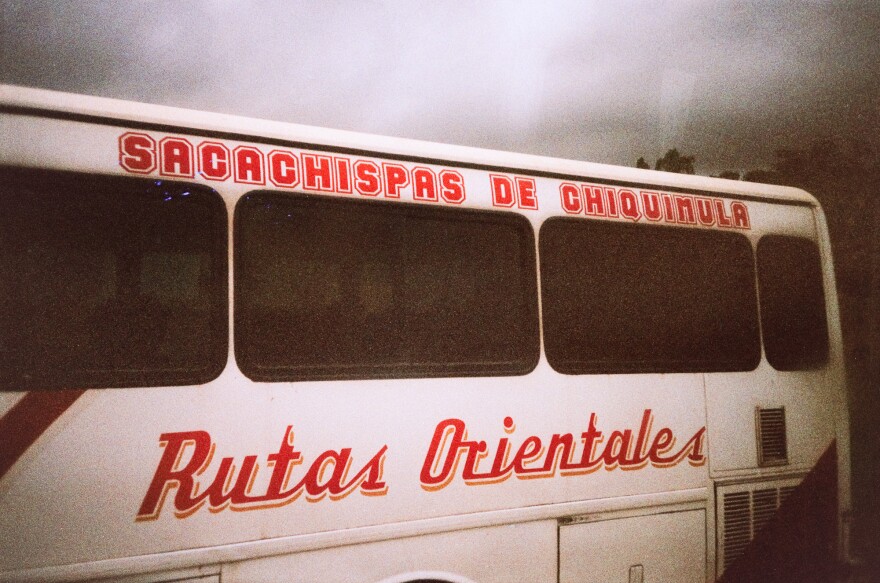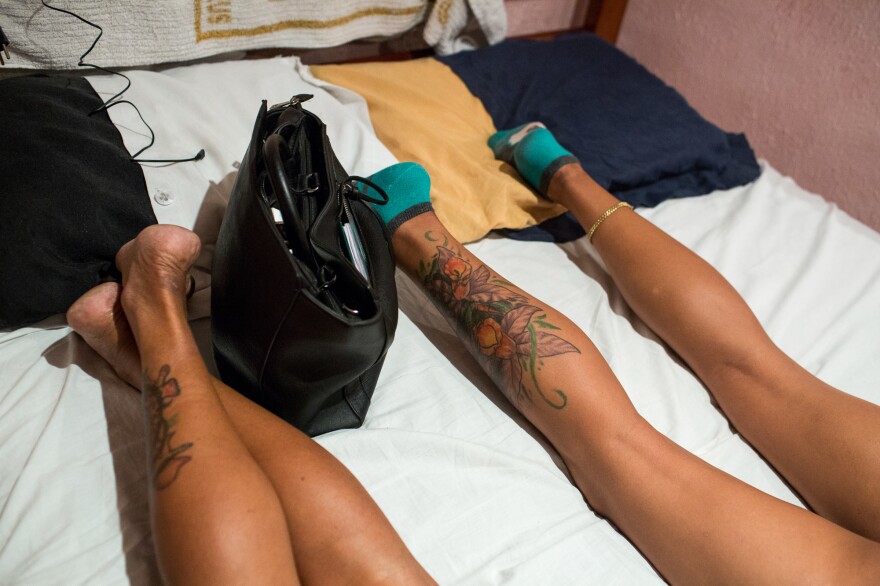Photojournalist Lisette Poole's new book of photographs was born out of a simple observation: Cuba was in the middle of a mass exodus, and it seemed to her that no one in Havana could keep their minds off it.
La paloma y la ley — which translates to "The dove and the law" — is a book of photographs and essays that documents the arduous migration journey of two Cuban women, Marta Amaro and Liset Barrios, from Havana to the U.S.
Poole shot photographs and took field notes as they traversed 13 countries and 10 borders over about 8,000 miles — with no set route or details beyond a piece of paper with the name of a human smuggler they hoped would guide them north. The book — Poole's first — is a collection of images that captures Marta and Liset on the move: on endless bus rides; in thick, wild jungles; and floating down rivers in rafts. In many of the photographs, the two women are pictured traveling alongside other migrants who hailed from countries that dot the globe: Somalia, Haiti, Nepal and Bangladesh, among others.



Poole's desire to document a migratory journey sparked in 2015, when tens of thousands of Cubans began leaving the island. In the wake of the Obama administration's efforts to thaw diplomatic tensions between the two countries, Cubans anticipated that a refugee policy would also unravel and thwart a decades-old path to lawful U.S. residency. That policy gave special preference to migrants fleeing Cuba without a visa to automatically stay in the U.S.
Poole, who is Cuban-American, said her ultimate goal in making the book was to "chip away at the illusion that American-born citizens are any different from those fighting to get here now." In her eyes, documenting the grueling journey had the potential to yield a humanizing migration story.
"In every little pocket of my life there was someone — who had someone — who was leaving, or had left," Poole said. "Or they themselves were thinking about it."
And Marta and Liset, two friends from a borough in Havana called Marianao, were no exception. Liset was 24 at the time, and a professional dancer and sex worker. She'd moved to Havana as a teenager with her mom, and they'd long struggled to make ends meet. Marta, then 52, had an adult son living in the U.S. She missed him. When Poole first met Marta in 2015, Marta said she was considering migrating. Poole asked if she could document her journey, and Marta agreed.
In May 2016, the trio boarded a flight to Guyana. The very next day, Poole snapped a photo of the pair standing amid brazen, green foliage, just before they illegally entered Brazil.
"I not only wanted to document the journey as close to what it would be like if I weren't there, but I also didn't want to hinder their ability to move quickly and easily," she said.


The entire way, Poole flew under the radar, posing as a migrant to, she says, avoid attracting unwanted attention or disrupting Marta and Liset's trajectory. Despite having a U.S. passport, Poole said she paid coyotes and crossed borders illegally alongside Liset and Marta.
She brought three cameras — one film and two digital — but she mostly stuck to her phone and GoPro. They were more discreet than the others, and less likely to blow her cover.
The photographs range widely in composition and style. Some were taken in the middle of the jungle or a river, and are adorned with water droplets. Others, shot on film, are dotted with green speckles; Poole noted their "beautiful, damaged quality," which she attributed to the mud and moisture of the Darien Gap, an endless stretch of jungle that separates Colombia from Panama.
Poole said that compiling the images for the book was like making sense of the "chaos of the journey itself."



Today, Poole continues to document Marta and Liset's stories. In 2017, Poole captured Marta in New Jersey, where she lives with her son. And in 2018, she photographed Liset preparing for her shift at a strip club in Texas. Bit by bit, Poole said, the two — who are permanent residents — have settled into their new lives.
But Liset and Marta's migration story, she noted, was "very much a picture of what it looked like for Cubans in that very moment in time." They were just two of the more than 41,000 Cubans who came to U.S. entry points at the Mexico border in fiscal year 2016. As it turned out, the pair left Cuba just in time. Six months after they entered the U.S., the Obama administration ended the special refugee policy that favored Cubans.


Now, Cubans are among the thousands of asylum seekers stuck in Mexico as they await court hearings in the U.S.
Regardless of who migrates, or where they go, Poole said, she believes nobody does so "just because they feel like it."
"They love where they're from, they love home. That's the place that made them who they are. So at the end of the day I think there will always be that longing [to return]."
Copyright 2023 NPR. To see more, visit https://www.npr.org.



